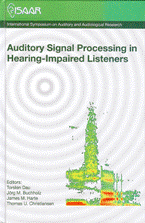Clinical applications of loudness scaling
Abstract
Fitting rules used in auditory rehabilitation usually have their main focus on detection thresholds. In state-of-the-art nonlinear hearing aids supra-threshold measures of the ear are also important and some of this information can be derived from loudness scaling. In three studies we examined the added value of loudness scaling for clinical applications. In a first study we performed loudness scaling in a group of musicians with primarily normal hearing. We measured loudness scaling with two narrowband (750 Hz and 3 kHz) and a broadband signal and investigated the relation with audiometric threshold. In a second study we examined the difference between monaural and binaural loudness perception in a subgroup of musicians. Finally we examined the correlations between self-reported problems and measures obtained from loudness scaling in a different group of hearing impaired employees. Our ndings indicate that unaided loudness scaling may not be appropriate as a basis for prescription rules, but aided loudness scaling can be used successfully as a verification tool in the fine-tuning stage and to compare different outcomes.
References
Marks, L. E. (1978). “Binaural summation of the loudness of pure tones,” J. Acoust. Soc. Am. 64, 107-113.
Reynolds, G. S., and Stevens, S. S. (1970). “Binaural summation of loudness,” J. Acoust. Soc. Am. 32, 1337-1344.
Scharf, B., and Fishken, D. (1970). “Binaural summation of loudness reconsidered,” J. Acoust. Soc. Am. 86, 374-379.
Whilby, S., Florentine, M., Wagner, E., and Marozeau, J. (2006). “Monaural and binaural loudness of 5- and 200-ms tones in normal and impaired hearing,” J. Acoust. Soc. Am. 119, 3931-3939.
Zwicker, E., and Zwicker, E. T. (1991).“Dependence of binaural loudness summation on interaural level differences, spectral distributions, and temporal distributions,” J. Acoust. Soc. Am. 89, 756-764.
Additional Files
Published
How to Cite
Issue
Section
License
Authors who publish with this journal agree to the following terms:
a. Authors retain copyright* and grant the journal right of first publication with the work simultaneously licensed under a Creative Commons Attribution License that allows others to share the work with an acknowledgement of the work's authorship and initial publication in this journal.
b. Authors are able to enter into separate, additional contractual arrangements for the non-exclusive distribution of the journal's published version of the work (e.g., post it to an institutional repository or publish it in a book), with an acknowledgement of its initial publication in this journal.
c. Authors are permitted and encouraged to post their work online (e.g., in institutional repositories or on their website) prior to and during the submission process, as it can lead to productive exchanges, as well as earlier and greater citation of published work (See The Effect of Open Access).
*From the 2017 issue onward. The Danavox Jubilee Foundation owns the copyright of all articles published in the 1969-2015 issues. However, authors are still allowed to share the work with an acknowledgement of the work's authorship and initial publication in this journal.


